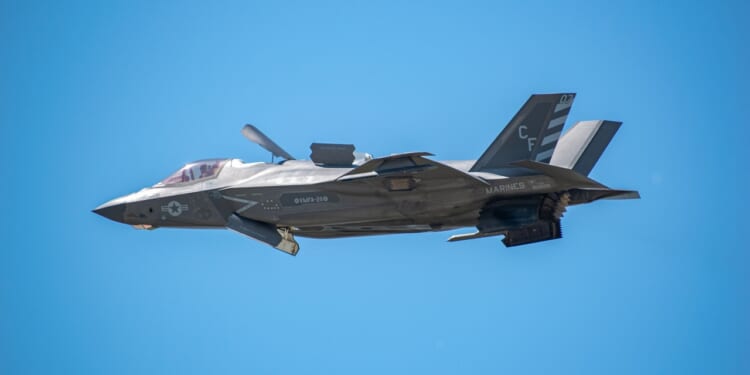Venezuela’s air defense network is nowhere near as sophisticated as a peer competitor’s. Yet Washington must not enter a conflict against Caracas believing it would be a cakewalk.
Hostilities between the United States and Venezuela appear to be imminent. Already, the Trump administration has escalated significantly both in terms of its military capabilities deployed off the coast of Venezuela—and the kinetic actions it has already taken against suspected drug running boats emanating from Venezuela.
While the Americans clearly enjoy tactical and technological supremacy over Venezuela, the fact that Caracas has an official military cooperation agreement with Russia means that Venezuela’s otherwise unimpressive military might have been given some capabilities that will make it a harder target to destroy than what the Trump administration might have thought at first glance.
Venezuela Says It “Saw” US F-35B Fighters
A strange incident occurred over the weekend in which Venezuela’s defense minister gave a press conference describing how Venezuela’s military detected US Marine Corps F-35B Lightning II warplanes. This should not have been possible. Indeed, it may well have just been bluster by the increasingly desperate and paranoid regime of Nicolas Maduro.
Then again, though, Russia might have given Venezuela some tools with which it could potentially track American warplanes—even supposedly advanced stealth planes like the F-35. Take, for example, the Russian-supplied S-300VM (NATO designation SA-23 Gladiator/Giant) air defense systems, which is designed with counter-stealth features. While the F-35B is a low-observable aircraft optimized to evade high-frequency radars, it can still be vulnerable to detection under certain conditions.
Stealth aircraft like the Marine Corps’ F-35B are engineered to absorb or deflect radar waves in higher frequency bands—particularly S-band and above)—but they are less effective against lower-frequency radars operating in the VHF (30-300 MHz) or UHF (300 MHz-3GHz) bands. These longer wavelengths interact differently with the aircraft’s shape and coatings, increasing the radar cross-section (RCS) of the stealth plane, and making detection more feasible at longer ranges. This might explain how the Venezuelans detected the American F-35Bs, if indeed they did.
Venezuela’s S-300VM system also incorporates other radars like the 9S19ME (High Screen-B) sector surveillance radar, which operates in the VHF band and has a detection range of up to 155 miles for conventional targets, with claimed effectiveness against low-observable aircraft. This radar is specifically touted for its anti-stealth roles, as it can supposedly spot aircraft designed to evade shorter-wavelength systems.
There are other components, such as the 64N6 (a.k.a. “Big Bird”) E/F-band acquisition radar (S-band, around two to four GHz) that, belying its name, is anything but harmless. It provides layered detection, though it is less optimal for stealth than VHF/UHF. When these two systems are combined, they could together allow Venezuela to detect an F-35B at ranges of 62-124 miles or more, depending on altitude, speed, and environmental factors.
Modern Russian Integrated Air Defense Systems (IADS), such as the kind that Venezuela today operates, use a multi-static approach where multiple radars (transmitters and receivers separated) work together. This can detect stealth aircraft by analyzing scattered signals or the “lack of return” in expected areas, rather than relying on direct reflections of radar waves off the F-35B’s composite, reflective skin.
From the S-300VM, Pechora-2M/SA-3 upgrades, and older systems, like the P-18 Spoon Rest in VHF have been integrated into a single, networked system by Venezuela. This allows data fusion from different frequencies and locations, potentially overcoming the F-35B’s stealth by building a composite picture of the airspace.
For instance, a lower-level VHF radar could cue a higher-frequency radar system for tracking once initial detection occurs.
Venezuela Should Still Fear the US Navy
Caracas’ recent claims of detecting the Marine Corps’ tranche of F-35B flying patrols in Venezuelan airspace are not the only time the regime in Venezuela has claimed to detect advanced American stealth planes. Back in 2016, and again in 2020, Venezuela allegedly utilized their Russian S-330VM radars to detect America’s most advanced warplane, the fifth-generation F-22 Raptor.
These systems reportedly achieved detection ranges up to 310 miles for stealth targets, though such claims are unverified and could involve favorable conditions like high altitude or non-optimal stealth configurations (with external stores, for example).
Remember, however: just because one can see a Marine-piloted F-35B doesn’t mean one can effectively intercept it. After all, the F-35B’s electronic warfare suite and speed could still allow the plane to evade or jam follow-on tracking, thereby stunting the ability of Venezuela to destroy the F-35B.
What’s more, detection is probabilistic and depends on factors, like the F-35B’s flight profile (low altitude reduces detectability), weather, electronic countermeasures, and maintenance of Venezuela’s aging systems. Even though VHF/UHF radars offer better initial detection, they provide lower resolution, making precise targeting harder without handover to higher-frequency radars.
Oh, and although Venezuela’s IADS is based on Russia’s, it is nowhere near as advanced as Russia’s. It has been described by some experts as a “hodgepodge,” and many understandably question the effectiveness of this IADS network against a full-blown US military operation involving scores of F-35Bs and support assets.
Nevertheless, Washington must not enter this fight against Venezuela believing it will either be a cakewalk or short-and-sweet. There are certain technologies that Venezuela has, gifted to them by Moscow, that could complicate the US military’s plans for victory in Venezuela. The US task force assigned to attack Venezuela must take these factors into account.
About the Author: Brandon J. Weichert
Brandon J. Weichert is a senior national security editor at The National Interest. Recently, Weichert became the host of The National Security Hour on America Outloud News and iHeartRadio, where he discusses national security policy every Wednesday at 8pm Eastern. He is also a contributor at Popular Mechanics and has consulted regularly with various government institutions and private organizations on geopolitical issues. Weichert’s writings have appeared in multiple publications, including The Washington Times, National Review, The American Spectator, MSN, The Asia Times, and others. His books include Winning Space: How America Remains a Superpower, Biohacked: China’s Race to Control Life, and The Shadow War: Iran’s Quest for Supremacy. His newest book, A Disaster of Our Own Making: How the West Lost Ukraine is available for purchase wherever books are sold. He can be followed via Twitter @WeTheBrandon.
Image: Shutterstock / Wirestock Creators.


















